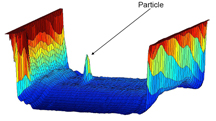Wednesday, February 11th, 2009
At Levitronix’s Ultrapure Fluid Handling and Wafer Cleaning Conference on February 11th, Particle Measuring Systems reviewed the limits of being able to detect things we do not want to find in flowing fluids, as enabled by a new digital detector array they call NanoVision Technology. Steven Verhaverbeke, tool design expert for Applied Materials who presented on particle mitigation concepts in tools, reminded attendees that particles smaller than 30nm are rare both in nature and in fabs, and that most particles are formed as part of processing and so can be anticipated and filtered. This is good since the latest ITRS says that the critical particle size today is supposedly 25nm.
Ross Bryant, of Particle Measuring Systems, reviewed the winter 2008 ITRS update and showed that the current specification for ultrapure water (UPW) counts any particles >50nm in size, while any of the various liquid chemicals (including post-CMP cleaning solutions) should be checked for particles >65nm.
UltraChem 40 is the brand name of the new tool that uses the NanoVision Technology. The detector arrays is composed of millions of digital detector elements that wrap around the flow tube to capture the scattered laser light from just a single particle (see figure). The tool can tune into particles while cutting out false signals such as molecular scatter. This all pushes the lower limit on detection to claimed 30nm in UPW and 40nm in chemicals, all with ~5% size resolution.
This new technique could conceivably be used as a large particle counter (LPC) in CMP, too. Since slurry is made of a distribution of small particles, only those >0.5µm count as problems and the digital signal trickery could be used as a high-pass filter to allow for LPC detection. With all of those digital pixels capturing data, there seems to be ample opportunity to extract productive information. –E.K.
Tags: 45nm, analysis, control, IC, ITRS, metrology, particle, spec

